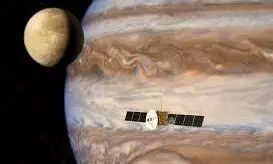
Europe’s JUICE probe makes historic lunar flyby en route to Jupiter
text_fieldsThe European Space Agency’s (ESA) Jupiter Icy Moons Explorer (JUICE) probe marked a significant milestone on Monday, August 19, by flying just 465 miles (750 kilometers) above the moon’s surface.
This close approach was part of a strategic "gravity assist" maneuver, the first of a historic doubleheader designed to set the spacecraft on its course towards Jupiter.
During the flyby, JUICE captured a series of images using its onboard monitoring cameras, which are primarily used to verify the deployment of the probe’s solar arrays and scientific instruments. These raw, unprocessed images were shared with the public in real-time through a live webcast, featuring insights from members of the JUICE team.
Launched in April 2023, JUICE’s mission is to explore Jupiter and three of its largest moons - Ganymede, Callisto, and Europa. These moons are believed to harbor vast oceans beneath their icy crusts, with Europa's ocean potentially interacting with a rocky seafloor, creating conditions that may support complex chemical processes.
The lunar flyby was the first in a series of gravity assists that will propel JUICE towards its final destination. The next gravity assist is scheduled for Tuesday, August 20, when the probe will pass by Earth, coming within 4,250 miles (6,840 kilometers) of the planet. This complex series of maneuvers, which also includes a future flyby of Venus in August 2025, will help JUICE reach Jupiter by July 2031.
According to JUICE spacecraft operations manager Ignacio Tanco, this approach is counterintuitive as it involves braking rather than accelerating the spacecraft, ultimately reducing the cruise time to Jupiter by about six months.
Without these gravity assists, the JUICE team would have needed to rely on the spacecraft’s propulsion system to achieve the necessary changes in velocity, which would have nearly depleted its fuel reserves. Fortunately, Monday’s lunar flyby was executed flawlessly, and no further adjustments were needed before the Earth flyby.
Although Tuesday’s Earth flyby will not be accompanied by another live webcast, amateur astronomers in the North Pacific region, particularly those in Alaska, may have a chance to spot the probe through a telescope. The closest approach is expected to occur at 5:57 p.m. EDT (2157 GMT) over the North Pacific Ocean.
This week’s successful maneuvers mark an important step in JUICE’s long journey to explore the Jovian system and its intriguing icy moons.























